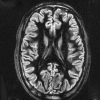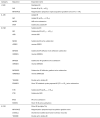New options for increasing the sensitivity, specificity and scope of synergistic contrast magnetic resonance imaging (scMRI) using Multiplied, Added, Subtracted and/or FiTted (MASTIR) pulse sequences
- PMID: 33014733
- PMCID: PMC7495319
- DOI: 10.21037/qims-20-795
New options for increasing the sensitivity, specificity and scope of synergistic contrast magnetic resonance imaging (scMRI) using Multiplied, Added, Subtracted and/or FiTted (MASTIR) pulse sequences
Abstract
This paper reviews magnetic resonance (MR) pulse sequences in which the same or different tissue properties (TPs) such as T1 and T2 are used to contribute synergistically to lesion contrast. It also shows how synergistic contrast can be created with Multiplied, Added, Subtracted and/or fiTted Inversion Recovery (MASTIR) sequences, and be used to improve the sensitivity, specificity and scope of clinical magnetic resonance imaging (MRI) protocols. Synergistic contrast can be created from: (i) the same TP, e.g., T1 used twice or more in a pulse sequence; (ii) different TPs such as ρm, T1, T2, and D* used once or more within a sequence, and (iii) additional suppression or reduction of signals from tissues and/or fluids such as fat, long T2 tissues and cerebrospinal fluid (CSF). The short inversion time (TI) inversion recovery (IR) (STIR) and double IR (DIR) sequences usually show synergistic positive contrast for lesions which have increases in both T1 and T2. The diffusion weighted pulsed gradient spin echo (PGSE) sequence shows synergistic contrast for lesions which have an increase in T2 and a decrease in D*; the sequence is both positively weighted for T2 and negatively weighted for D*. In the brain, when an IR sequence nulling white matter has subtracted from it an IR sequence nulling gray matter to form the subtracted IR (SIR) sequence, increases in the single TP T1 between the two nulling points of the original two sequences generate high synergistic positive contrast. In addition, the subtraction to produce the SIR sequence reduces fat and CSF signals. To provide high sensitivity to changes in TPs in disease the SIR sequence can be used (i) alone to provide synergistic T1 contrast as above; (ii) with T2-weighting to provide synergistic T1 and T2 contrast, and (iii) with T2- and D*-weighting to provide synergistic T1, T2, and D* contrast. The SIR sequence can also be used in reversed form (longer TI form minus shorter TI form) to produce very high positive synergistic T1 contrast for reductions in T1, and so increase the positive contrast enhancement produced by clinical gadolinium-based contrast agents (GBCAs) when they reduce T1. The specificity of MRI examinations can be improved by using the reversed SIR sequence with a long echo time (TE) gradient echo as well as echo subtraction to show synergistic high contrast from T1 and T2* shortening produced by organic iron. Other added and subtracted forms of the MASTIR sequence can be used synergistically to selectively show myelin, myelin water and fluids including blood and CSF. Protocols using MASTIR sequences to provide synergistic contrast in MRI of the brain, prostate and articular cartilage are included as illustrative examples, and the features of synergistic contrast MRI (scMRI) are compared to those of multiparametric MRI (mpMRI) and functional MRI (fMRI).
Keywords: Magnetic resonance imaging (MRI); Multiplied, Added, Subtracted and/or fiTted Inversion Recovery sequences (MASTIR sequences); articular cartilage; brain; contrast agents; prostate; pulse sequences; synergistic contrast MRI (scMRI).
2020 Quantitative Imaging in Medicine and Surgery. All rights reserved.
Conflict of interest statement
Conflicts of Interest: All authors have completed the ICMJE uniform disclosure form (available at http://dx.doi.org/10.21037/qims-20-795). JD serves as an unpaid editorial board member of Quantitative Imaging in Medicine and Surgery. The other authors have no conflicts of interest to declare.
Figures





























Similar articles
-
Improving the understanding and performance of clinical MRI using tissue property filters and the central contrast theorem, MASDIR pulse sequences and synergistic contrast MRI.Quant Imaging Med Surg. 2022 Sep;12(9):4658-4690. doi: 10.21037/qims-22-394. Quant Imaging Med Surg. 2022. PMID: 36060593 Free PMC article. Review.
-
Use of Multiplied, Added, Subtracted and/or FiTted Inversion Recovery (MASTIR) pulse sequences.Quant Imaging Med Surg. 2020 Jun;10(6):1334-1369. doi: 10.21037/qims-20-568. Quant Imaging Med Surg. 2020. PMID: 32550142 Free PMC article. Review.
-
Pulse sequences as tissue property filters (TP-filters): a way of understanding the signal, contrast and weighting of magnetic resonance images.Quant Imaging Med Surg. 2020 May;10(5):1080-1120. doi: 10.21037/qims.2020.04.07. Quant Imaging Med Surg. 2020. PMID: 32489930 Free PMC article. Review.
-
MRI diffusion-weighted imaging of the brain: contributions to image contrast from CSF signal reduction, use of a long echo time and diffusion effects.Clin Radiol. 1993 Feb;47(2):82-90. doi: 10.1016/s0009-9260(05)81178-x. Clin Radiol. 1993. PMID: 8382125
-
Inversion-recovery echo-planar MR in adult brain neoplasia.AJNR Am J Neuroradiol. 1998 Feb;19(2):267-73. AJNR Am J Neuroradiol. 1998. PMID: 9504476 Free PMC article.
Cited by
-
Improving the understanding and performance of clinical MRI using tissue property filters and the central contrast theorem, MASDIR pulse sequences and synergistic contrast MRI.Quant Imaging Med Surg. 2022 Sep;12(9):4658-4690. doi: 10.21037/qims-22-394. Quant Imaging Med Surg. 2022. PMID: 36060593 Free PMC article. Review.
-
Cardiac magnetic resonance imaging detection of intramyocardial hemorrhage in patients with ST-elevated myocardial infarction: comparison between susceptibility-weighted imaging and T1/T2 mapping techniques.Quant Imaging Med Surg. 2024 Jan 3;14(1):476-488. doi: 10.21037/qims-23-591. Epub 2023 Nov 28. Quant Imaging Med Surg. 2024. PMID: 38223054 Free PMC article.
-
Making the invisible visible-ultrashort echo time magnetic resonance imaging: Technical developments and applications.Appl Phys Rev. 2022 Dec;9(4):041303. doi: 10.1063/5.0086459. Appl Phys Rev. 2022. PMID: 36467869 Free PMC article. Review.
-
Targeted magnetic resonance imaging (tMRI) of small changes in the T1 and spatial properties of normal or near normal appearing white and gray matter in disease of the brain using divided subtracted inversion recovery (dSIR) and divided reverse subtracted inversion recovery (drSIR) sequences.Quant Imaging Med Surg. 2023 Oct 1;13(10):7304-7337. doi: 10.21037/qims-23-232. Epub 2023 Aug 15. Quant Imaging Med Surg. 2023. PMID: 37869282 Free PMC article. Review.
References
Publication types
Grants and funding
LinkOut - more resources
Full Text Sources
Medical
